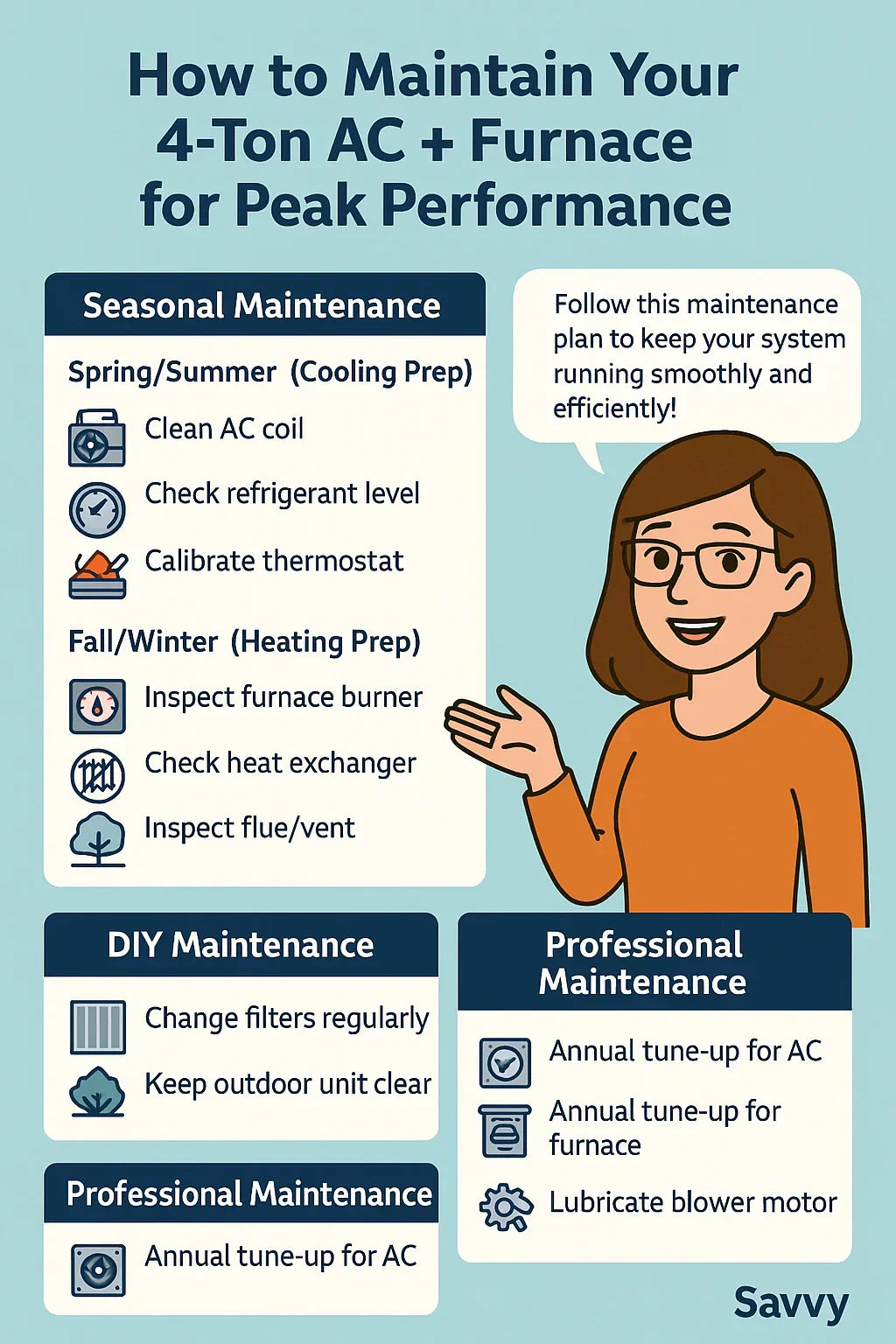1. Introduction – Why Maintenance Matters
Hi, Savvy here.
You know how skipping oil changes in your car is a guaranteed way to shorten its life and rack up repair bills? Your 4-ton AC + furnace combo works the same way. If you ignore it, it’ll ignore you — usually on the hottest day of summer or coldest day of winter.
A well-maintained HVAC system will:
-
Keep your home comfortable year-round
-
Use less energy (lower utility bills)
-
Last longer before needing replacement
I’ve seen homeowners stretch a system’s life to 20 years with consistent care. I’ve also seen units die in less than 10 years from pure neglect. The difference? A simple, seasonal maintenance plan.
This guide is your step-by-step playbook — with DIY tips, pro service advice, and Savvy shortcuts to keep your system running like a champ.
2. Understanding Your 4-Ton AC + Furnace System
Before we get into the checklist, let’s do a quick overview so you know what we’re maintaining.
A 4-ton system isn’t about weight — it’s about cooling capacity (48,000 BTUs/hour). In a typical AC + furnace combo:
-
The air conditioner handles cooling and humidity control in summer.
-
The furnace provides heat in winter.
-
They share the blower motor and ductwork, so issues with one can affect the other.
Think of them as two roommates sharing the same living space — if one’s messy, the other suffers too.
3. Seasonal Maintenance Schedule
Your system needs different care depending on the season.
Spring & Summer (Cooling Prep)
1. Clean the outdoor condenser coil
-
Dirt, leaves, and grass clippings reduce efficiency.
-
Turn off power, remove the top panel, and spray the coil from the inside out.
2. Check refrigerant levels
-
Low refrigerant = poor cooling + possible compressor damage.
-
A pro should handle this — it’s not DIY-safe.
3. Inspect and calibrate the thermostat
-
Make sure it’s reading accurately.
-
Upgrade to a smart thermostat for better control.
Fall & Winter (Heating Prep)
1. Inspect furnace burners
-
Dirty burners cause poor combustion and higher fuel bills.
-
A pro can clean and adjust them.
2. Check the heat exchanger
-
Cracks can leak dangerous carbon monoxide.
-
Only a licensed tech should perform this inspection.
3. Inspect flue and venting
-
Clear blockages to ensure proper exhaust flow.
Year-Round Tasks
1. Change air filters every 1–3 months
-
Clogged filters strain the blower motor.
-
Bonus: clean filters improve indoor air quality.
2. Keep outdoor unit clear
-
Maintain at least 2 feet of clearance all around.
3. Check condensate drain line
-
Prevent algae buildup with a vinegar flush twice a year.
4. DIY Maintenance Tasks
These are safe and effective to do yourself:
-
Change filters regularly (write the date on the frame).
-
Clean supply and return vents with a vacuum.
-
Check thermostat batteries annually.
-
Trim shrubs around the outdoor unit.
-
Listen for new noises — squeals, rattles, or grinding sounds.
Savvy tip: A simple notebook or phone note can track filter changes, pro visits, and repairs.
5. Professional Maintenance Tasks
Even if you’re handy, there’s no substitute for a trained HVAC technician once or twice a year.
For the AC (spring service):
-
Measure refrigerant levels and pressures
-
Inspect coil fins and straighten if bent
-
Test capacitor and electrical components
-
Verify temperature split between return and supply air
For the furnace (fall service):
-
Inspect and clean burners
-
Test safety controls
-
Measure combustion efficiency
-
Check and adjust blower speed if needed
6. Common Maintenance Mistakes
Avoid these habits if you want your system to last:
-
Skipping filter changes — This is the #1 killer of HVAC systems.
-
Blocking vents with furniture or rugs.
-
Letting leaves pile up around the outdoor unit.
-
Ignoring strange smells or noises — they rarely fix themselves.
7. Signs Your System Needs Service
Call a pro if you notice:
-
Uneven heating or cooling
-
Unexplained spike in utility bills
-
Frequent short cycling
-
Ice buildup on AC lines
-
Strange odors when the furnace runs
8. Extending the Lifespan of Your System
-
Regular tune-ups – twice a year (spring and fall).
-
Gentle thermostat adjustments – don’t crank settings drastically.
-
Fix small issues early – a $150 repair today can prevent a $1,500 breakdown later.
9. Cost of Maintenance vs. Cost of Neglect
| Service | Annual Cost | Potential Cost If Ignored |
|---|---|---|
| Annual AC tune-up | $100–$150 | Compressor replacement: $1,800–$3,000 |
| Annual furnace tune-up | $100–$150 | Heat exchanger replacement: $1,500–$3,500 |
| Filter changes | $60–$120 | Blower motor replacement: $500–$1,200 |
Savvy takeaway: Spending $200–$300/year on maintenance can save you thousands over the system’s life.
10. Savvy’s Maintenance Checklist
Monthly
-
Inspect and change filters if dirty
-
Check thermostat operation
Quarterly
-
Clear debris from outdoor unit
-
Inspect visible ductwork for leaks
Spring (Pro Visit)
-
AC coil cleaning
-
Refrigerant check
-
Electrical inspection
Fall (Pro Visit)
-
Furnace burner cleaning
-
Heat exchanger inspection
-
Safety control testing
12. External Verified Sources
In the Next topic we will read more about: Troubleshooting Guide: When Your AC or Furnace Isn’t Performing Well







